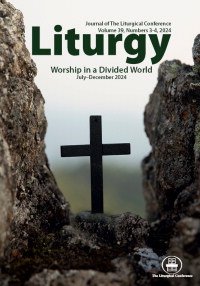In the Current Issue: "From Division to Encounter"
The issue of Liturgy entitled “Worship in a Divided World,” guest-edited by Benjamin Durheim, seeks to explore where our worshipping communities stand with regard to divisions that have pulled Christian worship patterns in divergent directions both negatively and, especially in recent times, positively as strengths. This excerpt is part of Hansol Goo’s essay “From Division to Encounter: Spatial Considerations for Hospitality in Shared Parishes,” explaining conclusions she and others have drawn from research with immigrant congregations worshipping in established churches of ethnic and racial communities not their own. –– Melinda Quivik
~ ~ ~ ~ ~
In the fourth century in North Africa and Italy. . . several factors in the ecclesial context led to the need to build freestanding baptisteries. Increase in the number of Christians and the growing structurization and hierarchization of the local church meant that a large structure dedicated to performing the baptismal ritual needed to be built adjacent to the basilica where the bishop of the local church presided. These examples demonstrate not only the developments in the history of architecture but the ways in which the early Christians accommodated the needs of the community through spatial adjustments and innovations. Change in the spatial setting for liturgy also meant change in the theological understanding of the liturgical space. We learn from Juliette Day’s study of fourth- and fifth-century baptisteries in Milan and Jerusalem that the entrance of the baptistery was an important space of threshold wherein the baptizand was introduced into the new life granted through baptism. The baptistery space functioned as a place of transformation in the baptizand’s life, where the baptizand’s old identity and value system were left outside the baptistery and, through the baptismal rite, the individual gained a new identity and a new belonging to the Christian community. It was precisely through the spatial configuration of the baptistery that the yet to be baptized could be welcomed into the new reality of remission of sins and communion with God and with the community of Christians.
At a shared parish, community members are called to practice hospitality toward one another and toward those who are not yet part of the parish community. Practicing hospitality spatially at a shared parish might include reconfiguring the worship space to accommodate culturally diverse ritual practices. . . Instead of the minority community occupying the worship space only during the time of their liturgy and then disappearing without a trace like an ephemeral “other,” the members of all sharing communities could make the worship space a common home that belongs to all by relying on the power of space to physically facilitate the diverse cultural expressions of each sharing community.
Parish is a common home that belongs to all who utilize the building. Pastoral strategies promoted by the United States Conference of Catholic Bishops and resources like Best Practices for Shared Parishes suggest practical solutions for accommodating cultural and linguistic diversity in a shared parish. In this book, the authors suggest that one of the later stages of development in ecclesial integration and inclusive stewardship is sharing of resources such as financial budget, time, and talent.
But I suggest that worship space as well as space for ministry activities must be included in the conceptuality of parish resources. Certainly, the pastor and staff at a shared parish already consider the worship space and other various facilities of the parish in making practical adjustments to accommodate multiple communities that belong under one roof. I hope that this article provided a theological perspective for reconceptualizing parish space so that the ministers and the parishioners can proactively use the parish space as a means for moving toward greater integration between the sharing communities.~ ~ ~ ~ ~
Hansol Goo is Assistant Professor of liturgical theology in the School of Theology at College of Saint Benedict and St. John’s University in Collegeville, Minnesota. Her research areas include liturgical and sacramental theology, theology of migration, ritual studies, global Catholicism, and Christian art and architecture.
Hansol Goo, “From Division to Encounter: Spatial Considerations for Hospitality in Shared Parishes,” Liturgy 39, nos. 3–4 (2024): 93–100, https://doi.org/10.1080/0458063X.2024.2369024.
